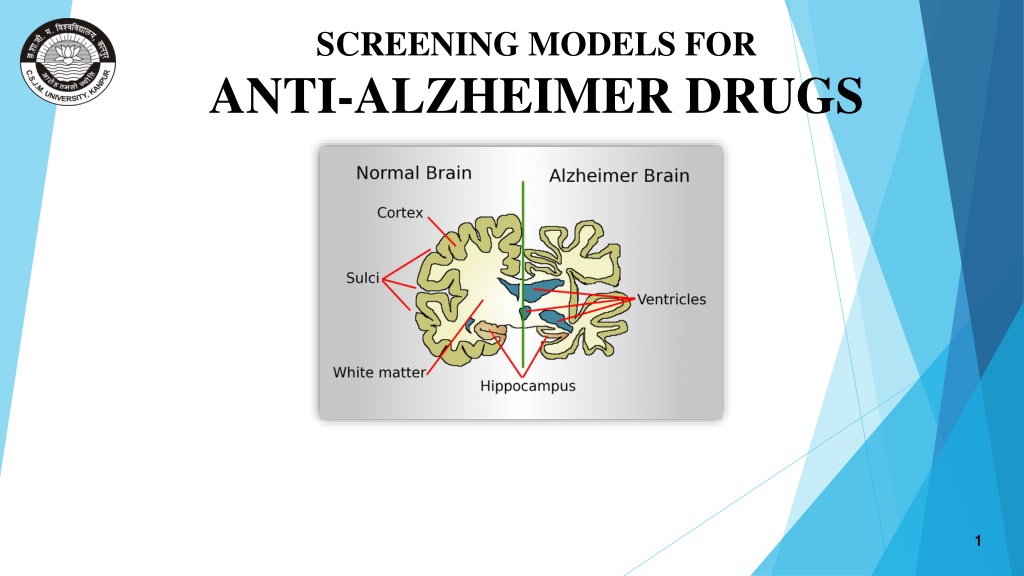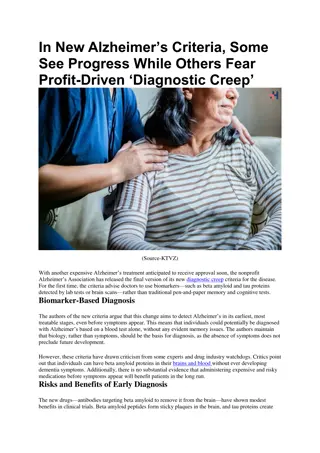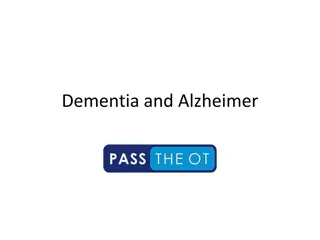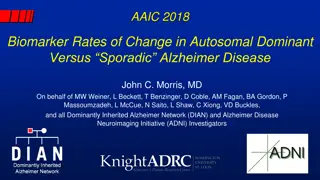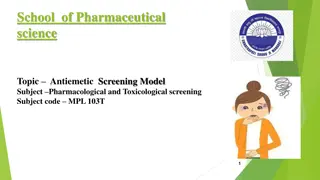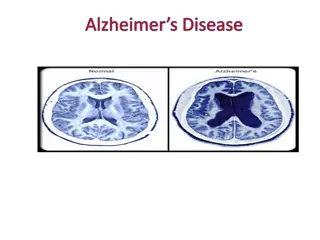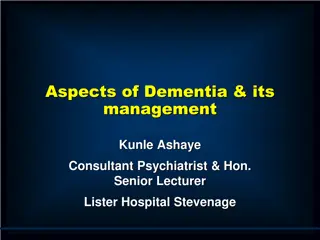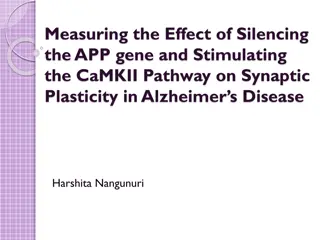Understanding Screening Models for Anti-Alzheimer Drugs
Alzheimer's disease is a prevalent neurodegenerative brain disorder characterized by memory loss and other cognitive impairments. This article discusses the etiology, risk factors, and pathophysiology of Alzheimer's disease, along with in-vitro screening models used to test potential drugs, focusing on acetylcholine esterase inhibition in rat striatum. The importance of studying and developing drugs targeted at slowing or reversing Alzheimer's disease progression is highlighted.
Download Presentation

Please find below an Image/Link to download the presentation.
The content on the website is provided AS IS for your information and personal use only. It may not be sold, licensed, or shared on other websites without obtaining consent from the author. Download presentation by click this link. If you encounter any issues during the download, it is possible that the publisher has removed the file from their server.
E N D
Presentation Transcript
SCREENING MODELS FOR ANTI-ALZHEIMER DRUGS 1
INTRODUCTION Alzheimer s disease is a neurodegenerative brain disorder. It is the most common form of dementia. It usually starts in late middle age or old age (above 50 years ) It is characterized by progressive memory loss. Formation of Neurofibrillary tangles and plaques containing beta-amyloid cells. SYMPTOMS Loss of memory Difficulty with communication Behavioral changes Difficulty in completing tasks. 2 MADE BY SANGEETA RAJPUT
ETIOLOGY AND RISK Strong genetic components. Tobacco Head-injury. Hypertension. Depression. Obesity Elevated serum cholesterol Elevated serum homocysteine Lack of intellectual stimulation/education 3 MADE BY SANGEETA RAJPUT
PATHOPHYSIOLOGY OF ALZHEIMERS DISEASE 4 MADE BY SANGEETA RAJPUT
SCREENING MODELS IN-VITRO IN-VIVO 5 MADE BY SANGEETA RAJPUT
IN-VITRO SCREENING MODELS 1. In Vitro Inhibition of Acetylcholine Esterase Activity in Rat Striatum 2. In Vitro Inhibition of Butyrylcholine Esterase Activity in Human Serum 3. [3H]N-Methylscopolamine Binding in the Presence and Absence of Gpp (NH)p 4. Stimulation of Phosphatidylinositol Turnover in Rat Brain Slices 5. [3H]N-Methylcarbamylcholine Binding to Nicotinic Cholinergic Receptors in Rat Frontal Cortex 6. Uncompetitive NMDA ReceptorAntagonism. 6 MADE BY SANGEETA RAJPUT
In Vitro Inhibition of Acetylcholine Esterase Activity in Rat Striatum PURPOSE AND RATIONALE: To screen drugs for inhibition of acetylcholine-esterase activity. As it is generally accepted that the physiological role of AChE is rapid hydrolysis and inactivation of Ach. Thus, inhibitors of of AChE show marked cholinomimetic effects in cholinergically -innervated effectors organs. Recent studies have suggested that AChE inhibitors may be beneficial for the treatment ofAD. PROCEDURE: 1. Reagents: a. 0.05 M Phosphate buffer, pH 7.2 b. Substrate in buffer(198 mg acetylthiocholine chloride) c. DTNB in buffer (19.8 mg 5,5-dithiobisnitrobenzoic acid)(0.5mM) d. A 2mM stock sol. of test, drug is made up of a suitable solvent and q.s to volume with 0.5mM DTNB. Drugs are serially diluted(1:10) such that the final conc. In the cuvette is 10-4 M and screened for the activity. 7 MADE BY SANGEETA RAJPUT
2. TISSUE PREPARATION: I. Rat are decapitated II. Brains are rapidly removed, corpora raita dissected free III. Weighed and homogenized in 19 volumes (approx. 7 mg protein/ml) of 0.05 M nah2 PO4, pH 7.2. IV. 25 l aliquot of this suspension is added to 1ml of the vehicle and various concentrations of test drugs are prepared. V. Reincubated for 10 min at 370c. 8 MADE BY SANGEETA RAJPUT
Inhibition of butyrylcholine-esterase activity in human serum: Purpose and Rationale: This method is used in conjunction with the acetylcholine-esterase assay to determine the enzyme selectivity of various cholinesterase inhibitors. Butyrylcholine-esterase preferentially hydrolyses butyrylcholine. This enzyme is found in the highest amount in serum, but its physiological role is not known. Ethopropazine and Tetra-Isopropyl Pyrophosphoramide (ISO-OMPA) are selective inhibitors of 110% butyrylcholinesterase. 9 MADE BY SANGEETA RAJPUT
Procedure: 1. Reagents: a. 0.05 M Phosphate buffer, ph 7.2 b. Substrate in buffer (225.8 mg s- butyrylthiocholine chloride) c. DTNB in buffer (19.8 mg 5,5-dithiobisnitrobenzoic acid) (0.5mM) d. A 2mM stock sol. of test drug is made up in a suitable solvent and q.s to volume with 0.5mM DTNB. Drugs are serially diluted(10) such that determined from the inhibitory activity of subsequent conc. 10 MADE BY SANGEETA RAJPUT
2. ENZYME PREPARATION: A VIAL OF LYOPHILIZED HUMAN SERUM RECONSTITUTED IN 3ML OF DISTILLED WATER 25 ml ALIQUOT OF THIS SUSPENSION ADDED TO 1ml OF THE VEHICLE & VARIOUS CONC. OF TEST DRUGS ARE PREPARED PRE-INCUBATE FOR 10MINAT 370C. 11 MADE BY SANGEETA RAJPUT
3. EVALUATION: For IC 50 determinations: Substrate conc. is 10 mM diluted 1:2 in an assay yielding a final conc. of 5 mM. DTNB conc. is 0.5 mM yielding 0.25 mM final concentration. % Inhibition= slope control - slope drug x 100 slope control IC 50 values are calculated from the log-probit analysis. 12 MADE BY SANGEETA RAJPUT
IN-VIVO SCREENING MODELS IN-VIVO MODELS Active Avoidance Passive Avoidance Shuttle Box Avoidance (Two-Way Shuttle Box) Jumping Avoidance (One-Way Shuttle Box) Step Through Step Down Two\compartment Test Scopolamine induced amnesia in mice Up Hill Avoidance 13 MADE BY SANGEETA RAJPUT
1. STEP-DOWN: Purpose and Rationale: An animal(mouse or rat) in an open spends most of the time close to the walls and in corners. When placed on an elevated platform in the center of a rectangular compartment, it steps down almost immediately to the floor to explore the encloser and approach the wall. This technique is employed in different modifications. 14 MADE BY SANGEETA RAJPUT
PROCEDURE:- REQUIREMENTS: a) Mice or rats of either sex are used. b) A rectangular box (50 50) with an electrifiable grid floor of 35 fits over the block. c) Grid floor is connected to the shock device. A typical paradigm consists of: a) Familiarization b) Learning c) Retention test 15 MADE BY SANGEETA RAJPUT
A) FAMILIARIZATION: Animal is placed on the platform Released after raising the cylinder Latency to descend is measured After 10 seconds of exploration, it is returned to the home cage 16 MADE BY SANGEETA RAJPUT
B) LEARNING: Immediately the animal has descended from the platform An avoidable shock is applied(foot shock: 50Hz: 1.5 mA; 1 sec Animal is returned to the home cage 17 MADE BY SANGEETA RAJPUT
C) RETENSION TEST: 24 hrs after the learning trail The animal is again placed on the platform step-down latency is measured The test is finished when the animal steps down or remains on the platform(cut-off time:60 sec) 18 MADE BY SANGEETA RAJPUT
EVALUATION: The time of descent during the learning phase and the time during the retention test is measured. A prolongation of the step-down latency is defined as learning. 19 MADE BY SANGEETA RAJPUT
2. SCOPOLAMINE-INDUCED AMNESIA IN MICE: Purpose and Rationale: The administration of anti-muscarinic agent scopolamine to young human volunteers produces transient memory deficits. Similarly, scopolamine impairs memory retention when given to mice. The ability of different cholinergic drug agonists to reverse the amnesic effects of scopolamine is now well documented in animal and human volunteers. 20 MADE BY SANGEETA RAJPUT
PROCEDURE: The scopolamine test is performed in groups of 10 male NMRI mice weighing 26-32 g in one trial Five min after I.P. administration of 3mg/kg of scopolamine hydrobromide. Each mouse is placed individually in the bright part of two chambered apparatus. After a brief orientation period, the mouse enters the second or darker chamber. Once inside the second chamber, the doors are closed to avoid escape. A 1 mA, 1-sec foot shock is applied through the grid floor. The mouse then returns to the home cage. 21 MADE BY SANGEETA RAJPUT
24 hrs. later, testing is performed by placing the animal again in the bright chamber. The latency in entering the dark chamber within 5 min test session is measured electronically. Whereas, untreated control animals enter the darker chamber in the second trial with a latency of about 250sec. Treatment with scopolamine reduces the latency to 50 sec. Test compounds are administered 90 min before training. The prolonged latency indicates that the animal remembers that it has been punished and, therefore, avoids the darker chamber. 22 MADE BY SANGEETA RAJPUT
EVALUATION: After treatment with various doses of test drug latencies obtained were expressed as % latencies. In some cases, a straight dose-response curve is obtained whereas with other drugs inverse U-shaped dose responses are observed. 23 MADE BY SANGEETA RAJPUT
